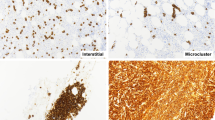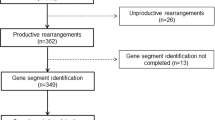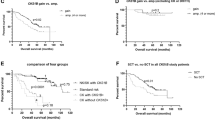Abstract
Chromosomal hyperdiploidy is the defining genetic signature in 40–50% of myeloma (MM) patients. We characterize hyperdiploid-MM (H-MM) in terms of its clinical and prognostic features in a cohort of 220 H-MM patients entered into clinical trials. Hyperdiploid-myeloma is associated with male sex, kappa immunoglobulin subtype, symptomatic bone disease and better survival compared to nonhyperdiploid-MM (median overall survival 48 vs 35 months, log-rank P=0.023), despite similar response to treatment. Among 108 H-MM cases with FISH studies for common genetic abnormalities, survival is negatively affected by the existence of immunoglobulin heavy chain (IgH) translocations, especially those involving unknown partners, while the presence of chromosome 13 deletion by FISH did not significantly affect survival (median overall survival 50 vs 47 months, log-rank P=0.47). Hyperdiploid-myeloma is therefore a unique genetic subtype of MM associated with improved outcome with distinct clinical features. The existence of IgH translocations but not chromosome 13 deletion by FISH negatively impacts survival and may allow further risk stratification of this population of MM patients.
This is a preview of subscription content, access via your institution
Access options
Subscribe to this journal
Receive 12 print issues and online access
$259.00 per year
only $21.58 per issue
Buy this article
- Purchase on Springer Link
- Instant access to full article PDF
Prices may be subject to local taxes which are calculated during checkout


Similar content being viewed by others
References
Bergsagel PL, Chesi M, Nardini E, Brents LA, Kirby SL, Kuehl WM . Promiscuous translocations into immunoglobulin heavy chain switch regions in multiple myeloma. Proc Natl Acad Sci USA 1996; 93: 13931–13936.
Chesi M, Bergsagel PL, Brents LA, Smith CM, Gerhard DS, Kuehl WM . Dysregulation of cyclin D1 by translocation into an IgH gamma switch region in two multiple myeloma cell lines. Blood 1996; 88: 674–681.
Chesi M, Nardini E, Brents LA, Schrock E, Ried T, Kuehl WM et al. Frequent translocation t(4;14)(p16.3;q32.3) in multiple myeloma is associated with increased expression and activating mutations of fibroblast growth factor receptor 3. Nat Genet 1997; 16: 260–264.
Chesi M, Nardini E, Lim RS, Smith KD, Kuehl WM, Bergsagel PL . The t(4;14) translocation in myeloma dysregulates both FGFR3 and a novel gene, MMSET, resulting in IgH/MMSET hybrid transcripts. Blood 1998; 92: 3025–3034.
Chesi M, Bergsagel PL, Shonukan OO, Martelli ML, Brents LA, Chen T et al. Frequent dysregulation of the c-maf proto-oncogene at 16q23 by translocation to an Ig locus in multiple myeloma. Blood 1998; 91: 4457–4463.
Smadja NV, Fruchart CC, Isnard F, Louvet C, Dutel JL, Cheron N et al. Chromosomal analysis in multiple myeloma: cytogenetic evidence of two different diseases. Leukemia 1998; 12: 960–969.
Debes-Marun CS, Dewald GW, Bryant S, Picken E, Santana-Davila R, Gonzalez-Paz N et al. Chromosome abnormalities clustering and its implications for pathogenesis and prognosis in myeloma. Leukemia 2003; 17: 427–436.
Fonseca R, Debes-Marun CS, Picken EB, Dewald GW, Bryant SC, Winkler JM et al. The recurrent IgH translocations are highly associated with nonhyperdiploid variant multiple myeloma. Blood 2003; 102: 2562–2567.
Fonseca R, Oken MM, Greipp PR . The t(4;14)(p16.3;q32) is strongly associated with chromosome 13 abnormalities in both multiple myeloma and monoclonal gammopathy of undetermined significance. Blood 2001; 98: 1271–1272.
Chng WJ, Van Wier SA, Ahmann GJ, Winkler JM, Jalal SM, Bergsagel PL et al. A validated FISH trisomy index demonstrates the hyperdiploid and nonhyperdiploid dichotomy in MGUS. Blood 2005; 106: 2156–2161.
Smadja NV, Bastard C, Brigaudeau C, Leroux D, Fruchart CC . Hypodiploidy is a major prognostic factor in multiple myeloma. Blood 2001; 98: 2229–2238.
Fonseca R, Blood E, Rue M, Harrington D, Oken MM, Kyle RA et al. Clinical and biologic implications of recurrent genomic aberrations in myeloma. Blood 2003; 101: 4569–4575.
Moreau P, Facon T, Leleu X, Morineau N, Huyghe P, Harousseau JL et al. Recurrent 14q32 translocations determine the prognosis of multiple myeloma, especially in patients receiving intensive chemotherapy. Blood 2002; 100: 1579–1583.
Shaughnessy J, Jacobson J, Sawyer J, McCoy J, Fassas A, Zhan F et al. Continuous absence of metaphase-defined cytogenetic abnormalities, especially of chromosome 13 and hypodiploidy, ensures long-term survival in multiple myeloma treated with Total Therapy I: interpretation in the context of global gene expression. Blood 2003; 101: 3849–3856.
Fassas AB, Spencer T, Sawyer J, Zangari M, Lee CK, Anaissie E et al. Both hypodiploidy and deletion of chromosome 13 independently confer poor prognosis in multiple myeloma. Br J Haematol 2002; 118: 1041–1047.
Fonseca R, Blood EA, Oken MM, Kyle RA, Dewald GW, Bailey RJ et al. Myeloma and the t(11;14)(q13;q32); evidence for a biologically defined unique subset of patients. Blood 2002; 99: 3735–3741.
Fonseca R, Harrington D, Oken MM, Dewald GW, Bailey RJ, Van Wier SA et al. Biological and prognostic significance of interphase fluorescence in situ hybridization detection of chromosome 13 abnormalities (delta13) in multiple myeloma: an eastern cooperative oncology group study. Cancer Res 2002; 62: 715–720.
Chang H, Sloan S, Li D, Zhuang L, Yi QL, Chen CI et al. The t(4;14) is associated with poor prognosis in myeloma patients undergoing autologous stem cell transplant. Br J Haematol 2004; 125: 64–68.
Bergsagel PL, Kuehl WM, Zhan F, Sawyer J, Barlogie B, Shaughnessy Jr J . Cyclin D dysregulation: an early and unifying pathogenic event in multiple myeloma. Blood 2005; 106: 296–303.
Oken MM, Leong T, Lenhard Jr RE, Greipp PR, Kay NE, Van Ness B et al. The addition of interferon or high dose cyclophosphamide to standard chemotherapy in the treatment of patients with multiple myeloma: phase III Eastern Cooperative Oncology Group Clinical Trial EST 9486. Cancer 1999; 86: 957–968.
Greipp PR, Lust JA, O'Fallon WM, Katzmann JA, Witzig TE, Kyle RA . Plasma cell labeling index and beta 2-microglobulin predict survival independent of thymidine kinase and C-reactive protein in multiple myeloma. Blood 1993; 81: 3382–3387.
Greipp PR, Leong T, Bennett JM, Gaillard JP, Klein B, Stewart JA et al. Plasmablastic morphology--an independent prognostic factor with clinical and laboratory correlates: Eastern Cooperative Oncology Group (ECOG) myeloma trial E9486 report by the ECOG Myeloma Laboratory Group. Blood 1998; 91: 2501–2507.
Greipp PR, San Miguel J, Durie BG, Crowley JJ, Barlogie B, Blade J et al. International staging system for multiple myeloma. J Clin Oncol 2005; 23: 3412–3420.
Fonseca R, Trendle MC, Leong T, Kyle RA, Oken MM, Kay NE et al. Prognostic value of serum markers of bone metabolism in untreated multiple myeloma patients. Br J Haematol 2000; 109: 24–29.
Ahmann GJ, Jalal SM, Juneau AL, Christensen ER, Hanson CA, Dewald GW et al. A novel three-color, clone-specific fluorescence in situ hybridization procedure for monoclonal gammopathies. Cancer Genet Cytogenet 1998; 101: 7–11.
Fonseca R, Bailey RJ, Ahmann GJ, Rajkumar SV, Hoyer JD, Lust JA et al. Genomic abnormalities in monoclonal gammopathy of undetermined significance. Blood 2002; 100: 1417–1424.
Fonseca R, Oken MM, Harrington D, Bailey RJ, Van Wier SA, Henderson KJ et al. Deletions of chromosome 13 in multiple myeloma identified by interphase FISH usually denote large deletions of the q arm or monosomy. Leukemia 2001; 15: 981–986.
Greipp PR, Trendle MC, Leong T, Oken MM, Kay NE, Van Ness B et al. Is flow cytometric DNA content hypodiploidy prognostic in multiple myeloma? Leuk Lymphoma 1999; 35: 83–89.
Jacobson JL, Hussein MA, Barlogie B, Durie BG, Crowley JJ . A new staging system for multiple myeloma patients based on the Southwest Oncology Group (SWOG) experience. Br J Haematol 2003; 122: 441–450.
Durie BG, Stock-Novack D, Salmon SE, Finley P, Beckord J, Crowley J et al. Prognostic value of pretreatment serum beta 2 microglobulin in myeloma: a Southwest Oncology Group Study. Blood 1990; 75: 823–830.
Bataille R, Boccadoro M, Klein B, Durie B, Pileri A . C-reactive protein and beta-2 microglobulin produce a simple and powerful myeloma staging system. Blood 1992; 80: 733–737.
Robbiani DF, Chesi M, Bergsagel PL . Bone lesions in molecular subtypes of multiple myeloma. N Engl J Med 2004; 351: 197–198.
Chang H, Stewart AK, Qi XY, Li ZH, Yi QL, Trudel S . Immunohistochemistry accurately predicts FGFR3 aberrant expression and t(4;14) in multiple myeloma. Blood 2005; 106: 353–355.
Keats JJ, Reiman T, Maxwell CA, Taylor BJ, Larratt LM, Mant MJ et al. In multiple myeloma, t(4;14)(p16;q32) is an adverse prognostic factor irrespective of FGFR3 expression. Blood 2003; 101: 1520–1529.
Garcia-Sanz R, Orfao A, Gonzalez M, Moro MJ, Hernandez JM, Ortega F et al. Prognostic implications of DNA aneuploidy in 156 untreated multiple myeloma patients. Castelano-Leones (Spain) Cooperative Group for the Study of Monoclonal Gammopathies. Br J Haematol 1995; 90: 106–112.
Winkler JM, Greipp P, Fonseca R . t(4;14)(p16.3;q32) is strongly associated with a shorter survival in myeloma patients. Br J Haematol 2003; 120: 170–171.
Chang H, Qi C, Yi QL, Reece D, Stewart AK . p53 gene deletion detected by fluorescence in situ hybridization is an adverse prognostic factor for patients with multiple myeloma following autologous stem cell transplantation. Blood 2005; 105: 358–360.
Drach J, Ackermann J, Fritz E, Kromer E, Schuster R, Gisslinger H et al. Presence of a p53 gene deletion in patients with multiple myeloma predicts for short survival after conventional-dose chemotherapy. Blood 1998; 92: 802–809.
Gertz MA, Lacy MQ, Dispenzieri A, Greipp PR, Litzow MR, Henderson KJ et al. Clinical implications of t(11;14)(q13;q32), t(4;14)(p16.3;q32), and -17p13 in myeloma patients treated with high-dose therapy. Blood 2005; 106: 2837–2840.
Rajkumar SV, Fonseca R, Dewald GW, Therneau TM, Lacy MQ, Kyle RA et al. Cytogenetic abnormalities correlate with the plasma cell labeling index and extent of bone marrow involvement in myeloma. Cancer Genet Cytogenet 1999; 113: 73–77.
Dewald GW, Kyle RA, Hicks GA, Greipp PR . The clinical significance of cytogenetic studies in 100 patients with multiple myeloma, plasma cell leukemia, or amyloidosis. Blood 1985; 66: 380–390.
Fonseca R, Barlogie B, Bataille R, Bastard C, Bergsagel PL, Chesi M et al. Genetics and cytogenetics of multiple myeloma: a workshop report. Cancer Res 2004; 64: 1546–1558.
Acknowledgements
RF is a Clinical Investigator of the Damon Runyon Cancer Research Fund. This work was supported by the Donaldson Charitable Trust, the International Waldenström Macroglobulinemia Foundation, and Grants R01 CA83724-01, SPORE P50 CA100707-01and P01 CA62242 from the National Cancer Institute, and the Fund to Cure Myeloma. PRG is supported by the ECOG Grant CA21115-25C from the National Cancer Institute. WJC is funded by an International Fellowship from the Agency for Science, Technology and Research (A*STAR), Singapore.
Author information
Authors and Affiliations
Corresponding author
Rights and permissions
About this article
Cite this article
Chng, W., Santana-Dávila, R., Van Wier, S. et al. Prognostic factors for hyperdiploid-myeloma: effects of chromosome 13 deletions and IgH translocations. Leukemia 20, 807–813 (2006). https://doi.org/10.1038/sj.leu.2404172
Received:
Revised:
Accepted:
Published:
Issue Date:
DOI: https://doi.org/10.1038/sj.leu.2404172
Keywords
This article is cited by
-
Lymphomas with plasmablastic features: a report of the lymphoma workshop of the 20th meeting of the European Association for Haematopathology
Virchows Archiv (2023)
-
RNA demethylase ALKBH5 promotes tumorigenesis in multiple myeloma via TRAF1-mediated activation of NF-κB and MAPK signaling pathways
Oncogene (2022)
-
High-risk disease in newly diagnosed multiple myeloma: beyond the R-ISS and IMWG definitions
Blood Cancer Journal (2022)
-
A simple additive staging system for newly diagnosed multiple myeloma
Blood Cancer Journal (2022)
-
Deciphering the chronology of copy number alterations in Multiple Myeloma
Blood Cancer Journal (2019)



